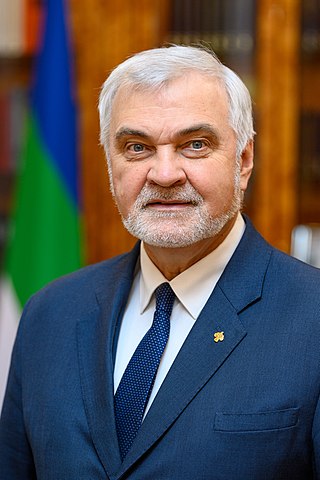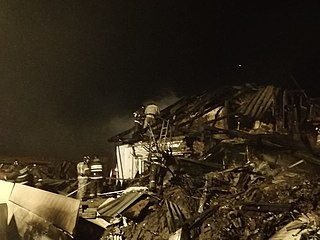Related Research Articles

MTV Russia or MTV Россия was a Russian music and entertainment TV channel, which carried out its broadcasting from 25 September 1998 to 31 May 2013. On 1 October 2013, MTV Russia was relaunched as a satellite pay TV channel.

Novy Urengoy Airport is an airport in Yamalo-Nenets Autonomous Okrug, Russia located 4 km southwest of Novy Urengoy. It handles medium-sized aircraft.

Soyuz 2 is a modernized expendable medium-lift launch vehicle and the seventh major version of the Soyuz rocket family. It includes key enhancements over its predecessors including improved engines along with digital flight control and telemetry systems, enabling launches from fixed platforms and the use of large payload fairings.

2×2 is a Russian television channel. Founded in 1989, it was the first commercial TV station in the Soviet Union. The channel was shut down from 1997 to 2003, at which point it was started up again. Since then, the channel has predominantly broadcast foreign animated TV series, including children's television series, anime, and adult animation shows.

Krasnoyarsk Metro System is a future subway system in the city of Krasnoyarsk, Russia. Construction began at a slow pace in the late 1990s, it is planned to be completed by 2027.

Disney Channel was a Russian free-to-air family federal channel, which was the local version of the American Disney Channel.

The Tornado is a family of related multiple rocket launchers developed by NPO Splav for the Russian Ground Forces. Variants of the system, which include the Tornado-G and Tornado-S models, have different capabilities and different battlefield roles. The Tornado is designed primarily to fire cluster munitions but also can be used to fire thermobaric warheads.
Rutube, stylized as RUTUBE, is a Russian video platform. It includes a library of licensed content including movies, series, cartoons, shows, and live broadcasts. It also hosts blogs, podcasts, video game streams, and educational content.
Bella Alexandrovna Nisan is a Russian ophthalmologist, founder of modern methods of vision disorder correction. She is a member of the American Academy of Ophthalmology and a well-known proponent of the use of jet-injection devices in medicine.

Resurs-P is a series of Russian commercial Earth observation satellites capable of acquiring high-resolution hyperspectral (HSI), wide-field multispectral (MSI), and panchromatic imagery. These spacecraft cost over 5 billion rubles and are operated by Roscosmos replacing the Resurs-DK No.1 satellite.
Yamal-202 is a geostationary communications satellite operated by Gazprom Space Systems and built by RSC Energia. It was, along with Yamal-201 the second dual launch of the Yamal program and the second iteration of the USP Bus. It is a 1,320 kg (2,910 lb) satellite with 4,080 watts of power on an unpressurized bus. It has eight SPT-70 electric thrusters by OKB Fakel for station keeping. Its payload is 18 C-band transponders supplied by Space Systems/Loral.
Yamal is a communication and broadcasting system developed and operated by Gazprom Space Systems. Born out of the connectivity needs of the natural gas extraction giant Gazprom, the system was spun off in its own company, and opened the network to third parties and even went into the public broadcasting industry. Yamal and Russian Satellite Communications Company (RSCC)'s Ekspress constellation are the only two national satellite operators in Russia.

This article contains the list of candidates associated with the 2018 Russian presidential election.

Vladimir Viktorovich Uyba, born in 1958, is a Russian statesman, scientist, and doctor, who is the acting Head of the Komi Republic since April 2, 2020. Before being appointed to that position, he was deputy health minister and head of the Federal Biomedical Agency.

Success Rockets is a private Russian space company that produces ultralight suborbital and orbital launch vehicles, small spacecraft, satellite constellations, and space tugs. The company was founded in 2020 by Oleg Mansurov. It has subsidiaries across Russia.

Vladimir Vladimirovich Mazur is a Russian statesman, who is currently serving as the 3rd governor of Tomsk Oblast in since 22 September 2022.

The crash of the Su-30 occurred at about 17:30 local time on 23 October 2022 in the city of Irkutsk in eastern Russia. The Su-30SM aircraft was performing a test flight when it fell on a wooden two-story residential building in 2nd Sovetsky Lane. Both the pilots were killed. The residents of the house were not hurt as they were not home.

Vyatka State University is a public university in Kirov, the capital city of Kirov Oblast in Russia. It was created in its current form in 2016 with the merger of the Vyatka State Humanitarian University and the Vyatka State Technological University.
References
- ↑ "Всех накрыло "Сферой"". www.comnews.ru (in Russian). Retrieved 18 November 2022.
- ↑ ""Сфера" получила "Эфир" и бюджет". www.kommersant.ru (in Russian). 18 July 2018. Retrieved 18 November 2022.
- ↑ ""Дочка" "Роскосмоса" представила спутниковую систему "Эфир" за ₽299 млрд". РБК (in Russian). 22 May 2018. Retrieved 18 November 2022.
- ↑ "Проект "Роскосмоса" по всемирному доступу в интернет назовут "Эфир" - РИА Новости, 22.05.2018". 22 May 2018. Archived from the original on 22 May 2018. Retrieved 18 November 2022.
- ↑ "Оцифрованные миллиарды". www.kommersant.ru (in Russian). 10 January 2018. Retrieved 18 November 2022.
- ↑ "Вести Экономика ― "Роскосмос" создаст конкурента OneWeb Satellites". 23 May 2018. Archived from the original on 23 May 2018. Retrieved 18 November 2022.
- ↑ "Прямая линия с Владимиром Путиным • Президент России". 10 June 2018. Archived from the original on 10 June 2018. Retrieved 18 November 2022.
- ↑ "«Сфера» получила «Эфир» и бюджет – Газета Коммерсантъ № 126 (6364) от 19.07.2018". 14 March 2022. Archived from the original on 14 March 2022. Retrieved 18 November 2022.
- ↑ "Рогозин сообщил, что "Сфера" будет включать пять спутниковых группировок для телекома - Космос - ТАСС". 25 October 2021. Archived from the original on 25 October 2021. Retrieved 18 November 2022.
- ↑ "Wayback Machine has not archived that URL" (PDF).[ dead link ]
- ↑ "Wayback Machine has not archived that URL".[ dead link ]
- ↑ "Началась сборка первого спутника глобальной российской системы "Сфера"". 1 August 2022. Archived from the original on 1 August 2022. Retrieved 18 November 2022.
- ↑ "Главное. Начались сборка и испытания первого спутника проекта "Сфера" - Новости - Госкорпорация "Роскосмос"". 8 August 2022. Archived from the original on 8 August 2022. Retrieved 18 November 2022.
- ↑ "Гендиректор ИСС Решетнева: мы разрабатываем пять спутниковых группировок для "Сферы" - Интервью ТАСС". TACC. Retrieved 18 November 2022.
- ↑ "Компания "ИСС" изготовит новый спутник связи". 18 January 2022. Archived from the original on 18 January 2022. Retrieved 18 November 2022.
- ↑ "Производитель сообщил, что группировка "Марафон" будет обновляться раз в пять лет". TACC. Retrieved 18 November 2022.
- ↑ "Более 130 спутников для интернета вещей "Марафон" запустят в 2025 году". TACC. Retrieved 18 November 2022.
- ↑ ""Никто не знает бизнес-модель Starlink и OneWeb": зачем нужна спутниковая группировка "Сфера" - Газета.Ru". 31 May 2022. Archived from the original on 31 May 2022. Retrieved 18 November 2022.
- 1 2 Новости, Р. И. А. (29 May 2022). "В "Роскосмосе" назвали сумму, необходимую для реализации проекта "Сфера"". РИА Новости (in Russian). Retrieved 18 November 2022.
- ↑ "Газпром космические системы / Новости / Больше, чем просто оператор спутниковой связи". www.gazprom-spacesystems.ru. Retrieved 18 November 2022.[ permanent dead link ]
- ↑ "Шесть спутников "Смотр" и 8 аппаратов "Ямал" планируется запустить в космос к 2035 году - гендиректор "Газпром Космические Системы" -". www.militarynews.ru. Retrieved 18 November 2022.
- ↑ "Шесть спутников "Смотр" и 8 аппаратов "Ямал" планируется запустить в космос к 2035 году - гендиректор "Газпром Космические Системы" -". www.militarynews.ru. Retrieved 18 November 2022.
- ↑ Специальный репортаж о новом созвездии «Сфера» (in Russian). Archived from the original on 24 October 2022. Retrieved 20 June 2023.
